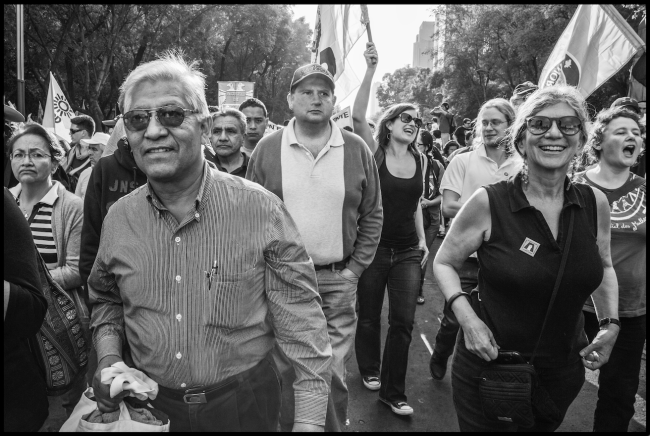
This is an abridged version of an interview published by the UCLA Center for Mexican Studies (CMS) and the UCLA Institute for Research on Labor and Employment (IRLE) Institute for Mexican Studies at UCLA. The interview is part of a series conversations with prominent Mexican labor leaders. Read Part I here.
For over two decades, Benedicto Martínez was general secretary of the Authentic Labor Front (FAT), one of the most important independent and progressive union federations in Mexico. During the same period, Robin Alexander was director of international relations for the United Electrical, Radio and Machine Workers of America (UE), an industrial union originally founded for workers in the electrical industry, and a bastion of democratic, rank-and-file unionism in the United States.
In the leadup to implementation of the North American Free Trade Agreement (NAFTA), the two unions formed a strategic alliance to help organize factories in Mexico and the United States and to advocate for political change to meet the needs of the workers of both countries. Thirty years later, the alliance remains a model for relations between U.S. and Mexican unions.
In this conversation, the two explain how the alliance was formed, what its principles were, and what it achieved. Alexander deals in more detail with this history in her book International Solidarity in Action. Here, Martínez and Alexander reflect on the changes caused by Mexico’s new labor law reform and the United States-Mexico-Canada Agreement (USMCA, called T-MEC in Mexico), which replaced NAFTA. The interview has been edited for clarity.
Robin Alexander: When we began the UE’s relationship with the FAT, neoliberal economic policies had caused the loss of thousands of jobs in our union. Companies moved them to other countries, mainly to Mexico. Our leaders thought it might be possible to find a union ally in Mexico, willing to try to reorganize these companies. At that time we had a relationship, more a paper one than a deep relationship, with the Mexican Union of Electrical Workers (SME). It is a very democratic union, but at that time it was in a more conservative period. The free trade agreement was on the horizon, and the SME’s leader, Jorge Sánchez, supported the policy of the Mexican government.
At a UE convention, the UE in Canada talked about the very negative impact of the U.S.-Canada free trade agreement on Canadian workers. Then a representative from the SME spoke in favor of a trade agreement with Mexico. This clash was the point when UE leaders thought, “we have to look for another relationship.”
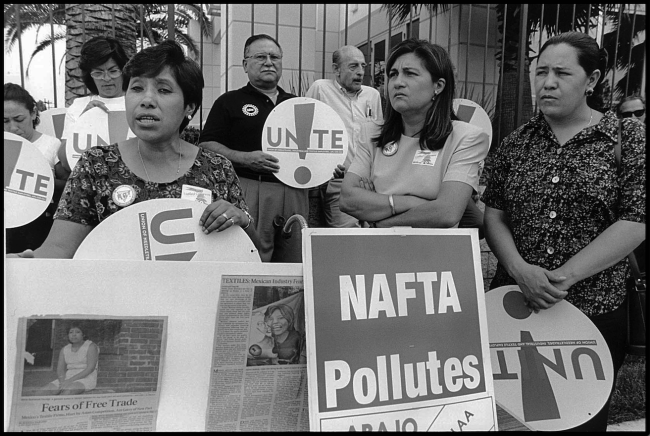
Benedicto Martínez: At that time the FAT began working with other organizations in Mexico to form the Mexican Action Network Against Free Trade (REMALC). The network gave us a way to look for allies in the United States. The AFL-CIO at that time had an open relationship with the Confederation of Mexico Workers (CTM), which supported the policies of the government of President Carlos Salinas.
In 1992, a representative of the UE came to a REMALC meeting in Zacatecas. I was negotiating a contract in Aguascalientes, and on a day when we didn’t have talks, I went to the Zacatecas meeting too. One of the FAT comrades, Manuel García, told me there was another trade unionist there, the only other one at the event. That’s how we found Bob Kingsley [former political director of the UE], who was also searching for an alliance with a Mexican union. A month later we were invited to Pittsburgh to meet with the UE leaders.
The UE felt the loss of jobs moving to Mexico and wanted a relationship between workers in the United States and Mexico from the same company, so that we could organize the runaway plants. We chose two plants that were among the largest: General Electric and Honeywell. We began a strategic alliance with an organizing approach.
We made the decision to start in Ciudad Juárez because there was already a study of the plants. I was put in charge of the Ciudad Juárez project and establishing the UE-FAT relationship.
We were received at the meeting with the UE’s leaders as if we had been old friends. We quickly established things that were important. Respect for autonomy was treated as a principle, and everyone took responsibility for making decisions in their own area. In Mexico it was up to us how to do things.
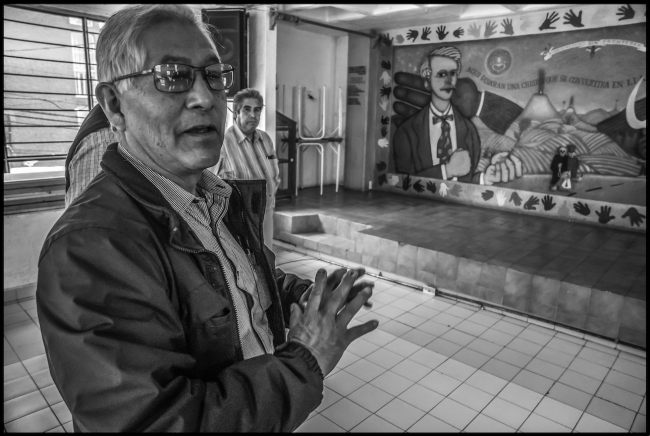
RA: We also agreed in 1992 to organize a tour against NAFTA in the United States, where representatives of the FAT would explain to workers why they thought it was a bad idea. The UE decided to establish a position of director of international relations.
It was a great challenge to develop international work in a way consistent with the UE’s principles as a union led by the rank and file. That is a fundamental difference from the hierarchical way most unions operate.
We did things by consensus. The UE was responsible for what happened in the United States and the FAT for what happened in Mexico. There was constant communication about what we were doing. In all the UE conventions from then on FAT representatives would speak with our members and we would develop the program for our work. We would exchange experiences about what we had done and plan for the future.
The first thing I did was accompany a delegation of grassroots UE representatives to Ciudad Juárez to support the organizing by the FAT against General Electric. This delegation was the first of many exchanges between the UE and the FAT. We also had cultural exchanges where murals were painted in both countries. There was a book project, in which a writer in the U.S. worked with a writer in Mexico to produce two books, one in English and the other in Spanish.
The campaign at General Electric failed, and we realized that we had not really understood well the complexity of organizing in Mexico, and all the barriers to it. I give a lot of credit to the UE leaders of that time because the reaction of many unions would have been “we cannot do it,” or “it was a good try.” But the UE, recognizing all the difficulties, said, “this is an important relationship, and we are going to continue supporting the FAT.”
The FAT at that time also made the decision to continue. To support them we made the first complaints under the NAFTA labor side-agreement. We had no confidence that we were going to win by making them, but they provided a platform for the FAT and allies in Mexico to denounce the illegal actions of the companies.
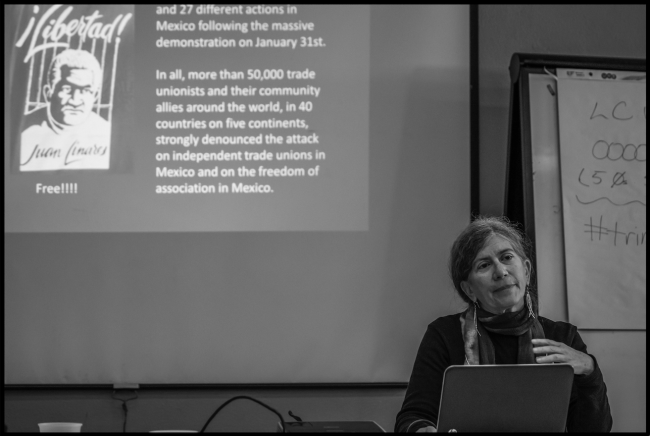
BM: Usually when someone provides financial support they make the decisions, they command. In this case it was different. We were fighting for the same cause in Mexico, and money meant more help organizing the workers. The situation in Ciudad Juárez was so difficult. We built a democratic movement based on the strength of the workers and were finally able to present the demand for a collective contract. But the state government flatly denied us. It was a brutal blow.
The UE understood that, under normal conditions, we would surely have won, but at GE and Honeywell we couldn’t, because the state forces were so strong. The principles we raised in those NAFTA complaints were finally written into the 2019 Federal Labor Law reform. That reform came out of those attacks against freedom of association and collective contracting, and the lack of justice at the federal and local conciliation boards. Today we have some protections in the law, but they came from the battles we fought 30 years ago.
It was difficult because the resources the UE provided came from workers’ dues. If we didn’t win, how could they justify the expense? We had to have a long-term perspective. We planted the seeds little by little. Our approach was to make visible the reality in Mexico—the lack of freedom, the lack of democracy, the lack of rights of Mexican workers—and to get other organizations and unions to take it on. Eventually they did.
Because of the complaints under the NAFTA side agreement and another at the International Labor Organization (ILO), we began to have more influence on other unions in the United States. Eventually we were able to exert pressure in the AFL-CIO.
We did grassroots work in U.S. local unions, but it was hard. On the first tour I was attacked by people who would call us “fucking Mexicans who come here to ask for help” or say “they are the ones who are going to get the jobs.” They said Mexico was willing to accept low salaries to get those jobs. They did not know that it was not a policy of the workers, but of companies in alliance with neoliberal governments. We’d explain that losing jobs was a product of the companies’ policy of transferring them.
Our relationship with the UE was very different. Although we worked mainly on organizing workers in Mexico, we needed to have allies from the same company in the United States, to be able to negotiate together. Our dream was to one day negotiate a contract with General Electric that would also cover Mexican workers.
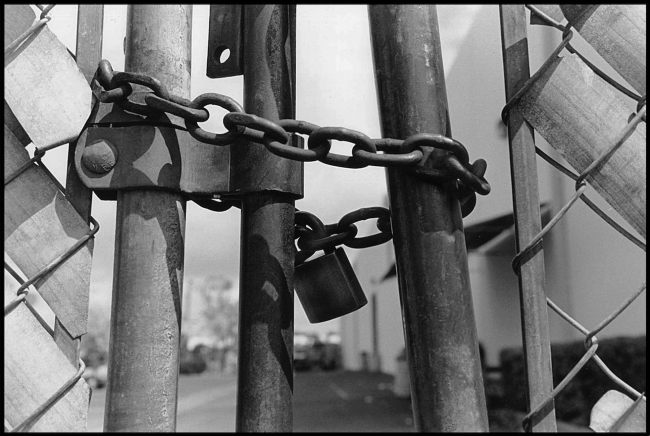
After many years talking with DMI/Metaldyne workers, it became our first success organizing a plant with a sister plant in the United States. We had the first meeting with coworkers who came from the U.S. plant to Mexico and later a delegation from Mexico went to the plant in the United States. They could see their machines were the same, although they were working under different conditions, and obviously for different salaries. But it was a big success for our alliance, after many years.
RA: Another early campaign was a company called ISKO. One of the workers from the General Electric struggle in Ciudad Juárez became an organizer. He was sent by the FAT to work in Milwaukee, where with his help we won that campaign. Solidarity is not only about economic support, or just from north to south. Solidarity also meant supporting organizing in the United States.
One delegation we sent to Mexico asked to focus on the legal right to bargain. These were workers from North Carolina, a state where public sector workers do not have the right to collective bargaining. They returned to North Carolina saying they’d learned this was a violation of international law. They organized the North Carolina International Justice Campaign, which had a great impact. Then the FAT also filed a lawsuit under NAFTA’s labor side agreement. In other UE locals workers began talking about it, that the FAT was fighting for the rights of UE members. It was very encouraging.
BM: Now things are changing because of the 2019 labor reform. Companies in Mexico that used to have a protection union [a company-controlled union] now think they’re better off without a union at all. The reform of the Federal Labor Law and the 2017 constitutional reform have led to the disappearance of the old labor boards and mandated free, direct, and secret personal voting. Whatever comes next, I think it will be difficult to reverse this.
However, the treaty has not affected all unions, but only those under the T-MEC mechanism. Mexico has more than 50,000,000 workers, and these complaints cover at most 20,000.

We have won a mechanism—the voting—and a process for the recognition of unions, but this process leads to rapid struggles and union formation. Building democratic unionism, with class-conscious workers, does not happen overnight. It requires education, which in the past came through conflicts. I don’t want to say that what happened in the past was good, but the more conflict and the longer the struggle, the more people learned. Their consciousness grew. When workers had to sustain a long-term struggle, they would gain more awareness of what is possible.
Today organizing is faster, but if we do not manage to create class consciousness, and commitment to democratic and militant unionism, I don’t know what the result will be. It could easily be a purely economic struggle. And that’s where I have my doubts and concerns.
Neither the CTM unions nor the established independent unions are organizing. It is not on their radar. The new actors are ones that have obtained resources through the Solidarity Center, like La Liga Obrera Mexicana, which are completely new, or like Julia Quiñones, who has spent her life working on the border, or Hector de la Cueva and CILAS. Those who are using the T-MEC process are the ones who are organizing.
Not all are successful. VU Manufacturing in Piedras Negras, where they also used the T-MEC, is about to close the plant. In another plant with 1,600 workers, about 700 voted and 900 did not. SINTIA [a new independent union that won an election and contract at a General Motors plant in Silao in 2022] won with 20 votes. It’s going to be very difficult to form a union. It is really a minority union.
But the traditional unions, the old independent unions, don’t even appear in this. It’s as if they are not interested.
It is not clear where our labor movement is going. The [old formerly government controlled] unions of the Labor Congress—the CTM, the CROC, the CROM—are supposedly now in compliance, with legitimized contracts, and elections they say were free, with direct and secret voting. How can workers tell the new unionism apart from these unions that still operate as they did before?
Nevertheless, the economic situation for workers has improved with the considerable increase in the minimum wage. A larger budget for social expenditures has also made life better, especially for the most unprotected workers. It has not reached the level we would like, but it is on an upward path.
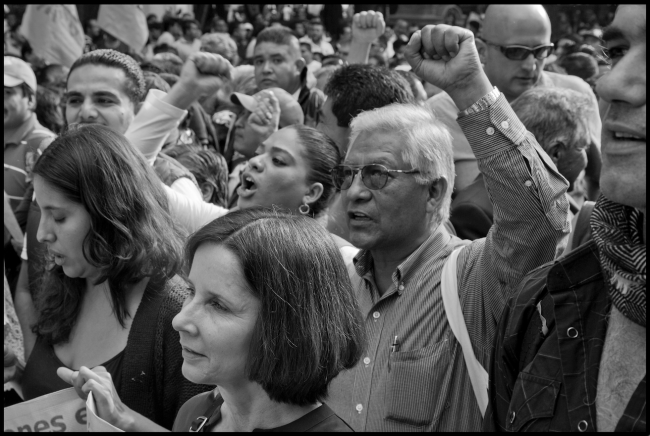
RA: During the years of our alliance, the Mexican government resolved labor issues directly or through the labor boards. That has also changed. Now the federal government says it is up to the parties to resolve labor issues, and they do not take sides. This is encouraging for the future. And, obviously, labor reform has created opportunities to organize without many of the obstacles that existed before.
However, there has been a lot of money, millions of dollars, coming from Canada and the United States to support this new unionism. We won’t know its impact for a while. Unionism in the United States is not a model workers should follow, and I don’t know the purpose of so much money. This is not a criticism of what has happened, but I am concerned about the unions that are being formed now. How democratic will they be? And if the money comes from the United States and Canada, what will happen when it’s taken away? The new unions are depending on T-MEC’s new rapid response mechanism. I hope that Trump does not win, but if he does, I cannot imagine that the rapid response mechanism will work as it has.
However, the organizing situation for workers now in the United States is very encouraging. There is movement, especially among young people, and we will also see where it goes. The UE has been very successful in organizing graduate students from universities, who are starting to win contracts. If this process continues, the UE will be in a much better position to focus again on international solidarity.
BM: I worry that the growth of new unions is based a lot on the present resources. But the status of the people who organize has changed, with high salaries for an organizer. In the past, you couldn’t even dream of this. If these resources stop, will the organizers continue?
I hope the union movement will re-emerge as all of us dream—strong, democratic organizations, with a relationship beyond our borders, as we managed to build with our alliance. The FAT’s dream for more than 40 years has been organizing unions by industry branch and by company. With General Motors, a contract covering the whole company could be powerful, or a strong alliance able to negotiate collective contracts in different countries, respecting autonomy and cultures.
David Bacon is a California-based writer and photographer, and former union organizer. He has written about Mexican labor and politics for over 30 years. His most recent book is More than a Wall / Más que un muro (Colegio de la Frontera Norte, 2022).

